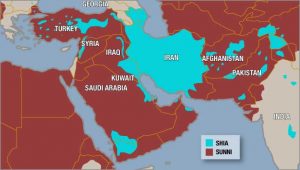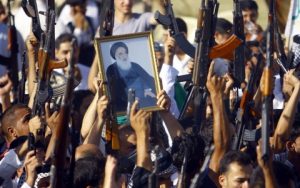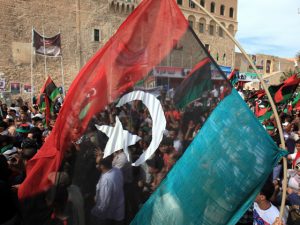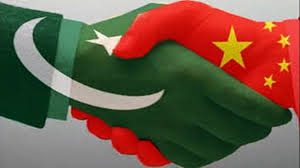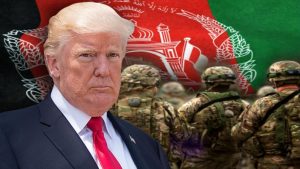The eruption of sectarianism in the Middle East is often depicted as the result of the reemergence of ancestral hatreds. The conflicts in Iraq, Syria, and Yemen would be the almost inevitable consequence of the split of Islam between Sunni and Shia Muslims shortly after the death of the Prophet Muhammad, a simmering animosity which periodically bursts out into violence, like reported by mei.edu.
Some experts have contested this interpretation, pointing out that such an eruption was not a spontaneous phenomenon, but a conscious policy adopted by certain authoritarian regimes seeking to forestall challenges to their legitimacy and ensure their own survival. At home, those regimes resorted to the classical divide-and-rule strategy to prevent the formation of broadly-based coalitions which could claim to represent popular will. Abroad, they manipulated sectarian differences to weaken their foreign enemies.
This article focuses on the ideological threat that prompted those authoritarian regimes to play the sectarian card: the spread of Islamism. It argues that, at its core, the rift in the Middle East is not a sectarian clash opposing Sunnis and Shiites — although after years of bloody conflict, many of the actors involved have come to see it that way. It is a geopolitical battle between, on the one side, states and groups aligned with the West and interested in preserving the regional status quo; and, on the other, states and groups characterized by their anti-Western rhetoric and eager to subvert that status quo. In some regards, it is a replay of what Malcolm H. Kerr called the Arab Cold War — but extended to Iran, and with Islamism replacing Arab socialism as the subverting ideology.
Islamism as a Destabilizing Factor
Islamism became a powerful political force in the 1970s, fomented by leaders such as Egyptian President Anwar al-Sadat and Pakistani President Zia-ul-Haq, who were seeking to consolidate their position and undermine the Left-wing parties and groups which had hitherto dominated the political landscape. Its growth was financed by autocratic regimes which felt threatened by the popularity of revolutionary ideologies on the Arab and Muslim streets, particularly Saudi Arabia. Over the previous decades, the Kingdom had welcomed thousands of Muslim Brothers fleeing Egypt, Syria, and Iraq, and provided their organization with the resources to operate and expand in the Muslim world and beyond. In the changing environment of the 1970s and 1980s, the Islamists attracted wide public support by virtue of their populist rhetoric, but also the basic services they offered to rapidly growing populations in increasingly overcrowded cities. But they had their own agenda, different from that of the regimes which backed or, at least, tolerated them. A clash was inevitable.
Egypt was central to developments, as it had been between the 1930s, when Islamism first became a mass movement under the leadership of Hassan al-Banna, and the 1950s, when Sayyid Qutb was its most influential ideologue. Sadat’s ideological, political and economic realignment was resisted by Nasserists and other Leftists. In order to counter them, he released the Muslim Brothers from prison, encouraged the appearance of Islamist groups at Egyptian universities, and portrayed himself as “the pious president” (al-ra’is al-mu’min). However, opposition to his policies induced Sadat to become ever more authoritarian. For the Islamists, the last straw was the signature of the Camp David Accords in 1978. In 1981, Sadat was assassinated by Islamic Jihad, who were confident that their action would incite a popular uprising. It did not happen. Nor did the ensuing repression eradicate the Islamist groups. Instead, Egypt experienced a period of low-intensity civil war, which peaked in the 1990s with the return of the “Afghan Arabs.”
But the emergence of Islamism had its most dramatic consequences in Iran. Iranian Islamism, despite its specificities — it was not Arab and Sunni, but Persian and Shiite — was influenced by Sunni Islamism as it developed in the Arab world. And the Islamic Revolution responded to dynamics similar to those in Egypt: It was to a great extent a reaction against a regime that was both oppressive and closely allied to the US. The mobilizations against the Shah had a wide popular base, but eventually Ayatollah Khomeini and his followers were able to steer them in their favor and take over. Khomeini made no secret of his desire to export his revolution, posing a serious ideological challenge to Iran’s Arab neighbors, especially those with significant Shiite populations. Iraq, Kuwait, Bahrain, and Saudi Arabia all saw major Shiite disturbances, which contributed to Saddam Hussein’s decision to attack Iran in 1980 and to the Gulf monarchies’ support for Iraq during the ensuing eight-year war.
Not even Saudi Arabia was spared the destabilizing effects of Islamism. Many of the Muslim Brothers who arrived in the country in the 1950s and 1960s were highly qualified professionals, and they went on to make a significant contribution to the development of the Kingdom, particularly in the civil service and higher education. Some of them, such as Sayyid Qutb’s younger brother, Muhammad, became influential among certain sectors of the Saudi intelligentsia, giving rise to the Sahwa (Awakening) movement. The latter combined Salafism and Islamism and sought political reform, challenging the despotism of the ruling family. The movement became very vocal after Saddam Hussein invaded Kuwait in 1990 and King Fahd invited foreign troops into Saudi Arabia to protect it from Iraqi aggression. The Saudi authorities decided that the Muslim Brotherhood was more trouble than it was worth and scaled back their support for the organization, focusing instead on Salafi shaykhs and groups. Keen to raise its international profile, Qatar was happy to take over and become the Brotherhood’s main backer.
The Impact of the Arab Spring
Despite their political differences, relations between Iran and Saudi Arabia gradually improved after the Iraqi invasion of Kuwait, which Tehran condemned. The 1990s ended with Mohammad Khatami paying an official visit to Riyadh, the first by a president of the Islamic Republic, and in April 2001 the two countries signed a security agreement. The trend continued with President Mahmoud Ahmadinejad, in spite of his more belligerent rhetoric and arguably because the Gulf monarchies felt reassured by the ever-growing US involvement in the Middle East under George W. Bush. In 2007 Ahmadinejad visited Saudi Arabia and, later that year, became the first Iranian president to attend a Gulf Cooperation Council meeting, during which he proposed a security pact and a free trade agreement.
The situation changed after Barack Obama became US president and opted for a less interventionist approach in the Middle East. Fatefully, this coincided with the outbreak of the Arab Spring. To Saudi Arabia’s dismay, Obama refused to prop up Washington’s traditional Arab allies, notably Egyptian president Hosni Mubarak, and seemed eager to work with his democratically-elected successor, Muslim Brother Mohamed Morsi. Obama was also reluctant to support the Syrian rebels who took up arms against Bashar al-Assad. Worse, he was willing to overlook the role of Tehran in that conflict and continued the negotiations over Iran’s nuclear program. Symptomatic of the new regional climate was Morsi’s participation in a summit of the Non-Aligned Movement in Tehran in August 2012, which was followed by Ahmadinejad’s trip to Cairo in February 2013 — the first such exchange of visits since the Islamic Revolution.
The Islamists were the political force best placed to take advantage of the 2011 popular revolts, which Iran hastened to portray as the second wave its own “Islamic Awakening.” In order to promote this narrative, Tehran set up the World Assembly for the Islamic Awakening, which held its first conference in September that year. It was reportedly attended by over 700 delegates from 84 countries, and the themes were familiar: the existence of a single, worldwide Muslim Ummah, which should be united against “the predatory powers led by the US”; the promotion of an Islamic system of governance “backed and supported by the will of the people” and distinct from Western-style democracy; and support for the “valiant struggle of the people of Palestine facing Zionist aggression.” Those themes resonate with large swaths of the Arab and Muslim streets, where there is resentment over Western interventionism and perceived arrogance, and widespread solidarity with the long-suffering Palestinians.
But Tehran’s vision had a fundamental weakness: Syria. In fact, there was great uneasiness in Iran about supporting Bashar al-Assad when he repressed the demonstrations demanding democratic reforms in 2011. Even hawkish Ahmadinejad criticized the use of violence by Assad’s government and admonished him to be accountable to his people’s demands. However, Syria is crucial for Iran: it is its only longstanding Arab ally, and a key component of its “Axis of Resistance,” providing access to the Levant — the main arena of the Arab-Israeli struggle — and serving as a major channel for assistance to Hezbollah. In addition, Sunni states soon started backing Salafi militias within the Syrian rebellion. For Saudi Arabia, it meant killing two birds with one stone: getting rid of a hostile neighbor and, simultaneously, undermining Iran’s narrative by framing Tehrna’s actions in sectarian terms. Its own propaganda machine swung into full gear.
Sectarianism and Islamism as Political Strategies
The Iranian leadership felt that it had no choice but to throw in its lot with Assad. It insisted on its own propaganda, labelling Syria “the golden link in the chain of resistance” which stretches from Iran to Hezbollah and Hamas. In addition, it emphasized the support of the Islamic Republic for Sunni Muslims, especially in Palestine, and denounced takfiri groups such as Daesh as part of a Western-Zionist ploy to stain the reputation of Islam and divert attention from the fight against Israel. With limited success: As well as exacerbating sectarian tensions across the region, the situation in Syria has put considerable strain on the relationship between the Iranian regime and Sunni Islamists like Hamas. And it has done much harm to the reputation of Hezbollah, formerly lionized for its role in the Arab-Israeli conflict.
The threat posed by the Islamist ideology promoted by Iran thus played a significant role in Saudi Arabia’s decision to foment sectarianism by sponsoring Salafism. That threat also explains Saudi moves against the Muslim Brotherhood, notably favoring the coup that deposed Morsi in July 2013 and adding it to its list of terrorist organizations in March 2014 — alongside Daesh and al-Qaeda-linked Jabhat al-Nusra! It also throws light on the rift with Qatar, which already made headlines in 2014. With the highest GDP per capita in the world and a homogenous indigenous population, the House of Al Thani is less concerned than neighboring dynasties about the possibility of challenges to its rule. However, other Arab states have long been irked by its support for the Muslim Brotherhood and by Al-Jazeera’s pro-Islamist bias.
But if Saudi Arabia is anxious about regime survival, so is Iran. The recent decisive reelection of President Hassan Rouhani over the candidate backed by Supreme Leader ‘Ali Khamenei has yet again illustrated the unpopularity of the conservative forces which control the Islamic Republic. Many Iranians saw the Arab Spring not as the second wave of the Islamic Revolution as purveyed by the official propaganda, but as a continuation of their own mobilizations in 2009-2010, when they protested against the likely electoral fraud that allowed Ahmadinejad to obtain a second term. Those mobilizations were harshly repressed, while demonstrators, dubbed the “Satanic current,” went on to create the Green Movement that brought Rouhani to power in 2013. For the Iranian regime, foreign policy is crucial to strengthening its shaky position at home.
Conclusion
As this historical overview shows, taking a long-term perspective can be very useful in the analysis of present-day events. In this case, the dynamics brought about by Islamism shed light on the conflict between Saudi Arabia and Iran, which is the main factor behind the current instability in the Middle East. As we have seen, the Saudi regime promotes Sunni sectarianism in order to present itself as a defender of Islamic orthodoxy and depicts Iran as a fanatical Shiite state moved by purely sectarian motives. Conversely, the Iranian regime promotes Islamism not only because it is the ideology upon which the Islamic Republic is built, but also to attract Sunni Muslims with a narrative which glosses over sectarian differences and questions the legitimacy of its Western-aligned rivals. Recognizing these motivations reveals that the conflict is more political than sectarian, which means that it could be tackled if the political will was there, and that Sunnis and Shiites are not locked in an eternal struggle against each other.
